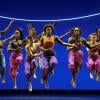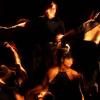
Thirty years ago, as a professional ballet dancer, I did an outreach visit to a public school in Cleveland, Ohio, and one particular young girl in the audience left an indelible impression. After the dance demonstration, a teacher brought her forward, explaining the student was blind and wanted to better understand all she had heard. It’s impossible to forget how the student’s face lit up when — placing her hands on my arms, torso, legs, and finally, my feet in pointe shoes — she explored the haptic (or tactile touch) terrain.
Carefully keeping her hands affixed, I rose up and down on my toes. I tapped the hard toe of one shoe on the floor. She said, “That’s what made those knocking sounds I heard when you danced, isn’t it?” Then she asked, “What does it feel like to dance like a swan?” With that, I invited her to stand on my feet and wrap her arms around my waist. Humming the music and describing the steps as we waltzed and spun around the room, I was offering what you might call an early audio-described performance. She said when we stopped, “Now I’m a swan dancer, too.”

That long-ago haptic and audio tour was like an impromptu version of the accessibility project that Cal Performances launched for two productions in 2022. The performing arts presenter at UC Berkeley then implemented an expanded menu of haptic and audio offerings for its 2023–2024 season. According to Executive and Artistic Director Jeremy Geffen, Cal Performances’ commitment to increasing audience access is ongoing and permanent. It’s part of the phenomenal explosion in the last four years of efforts to make the performing arts more accessible to people living with visual and auditory disabilities.
“We discovered a need we weren’t addressing,” says Geffen. “It happened organically. We had a staff member who’d worked for Gravity Access Services [which is based in San Francisco]. A call came in from a patron asking if we supplied access services. We piloted the program, [and] it’s been transformational for a subset of our audience. Pairing haptic tours with live audio performances speaks to our strategic planning. One goal is to open our halls wide, give access to people of all backgrounds. It’s critical we keep asking ourselves how we’re serving the broadest spectrum of our population.”
Gravity was founded by the late choreographer and director Jess Curtis, who died suddenly on March 11 at the age of 62. His contributions to accessibility in the arts included choreographing physically inclusive dance and educating young professionals, students, and members of the public in workshops throughout the U.S. and Europe. Among Gravity’s services are live and recorded audio descriptions of performances, preshow haptic access tours, sign language referrals, and general accessibility consulting and advising.
Confronting challenges such as how best to use Cal Performances’ limited backstage space for haptic tours of large productions has required careful planning, says Geffen. “The logistics of lots of people and equipment moving among patrons on tours is complex. Most productions we bring in travel with staff, so we’re not presenting this from the ground up. They have interest, and we’ve worked it out with their personnel to find a guide for haptic tours. And Gravity’s local describers can be used for the performances. There’s nothing that seems insurmountable about this.”
The performances that work best for both haptic tours and live audio descriptions are dance and theater productions that offer a mix of visual and auditory elements, says Geffen. But he’s open to wider usage, such as for orchestral performances. Another idea that gets him excited is spreading awareness of Gravity’s programs to more departments on UC Berkeley’s campus. “We need to make a push beyond arts-focused departments because faculty and students in other areas will open other applications [of this technology].”

Michael Whitson became Gravity’s managing director in 2022 and has a long history in community arts engagement in the Bay Area, including as co-founder of 848/CounterPulse. Still reeling from Curtis’s sudden death, Whitson says, “It’s been a huge change, and we’re still in shock, disbelief, and grief. But the organization is in good health financially and organizationally. A large part of [Curtis’s] legacy is caring about people with disabilities and providing opportunities for audio- and sight-impaired people. He did the work to manifest Gravity and to have clients all over the world.”
Arts organizations, Whitson says, are eager to increase accessibility but lack knowledge. “They’ve never heard of haptic tours, or maybe they don’t know technical things, like that our describers sit embedded in the audience and use a muffle mic. That way, they provide an actual audience-member perspective but don’t disturb anyone.”
Gravity helps with community outreach, spreading the word about various initiatives and programs to the general public and to agencies supporting people with disabilities. The organization also provides training and best-practices guidelines for tour leaders and audio describers.
“Professional audio describers are highly skilled in the art form,” says Whitson. “They must be concise but also provocative. The golden rule is to not describe too much and let the listener make their own interpretation of what is happening.” For theater, it’s essential the describers speak only when there is no dialogue. The descriptions might be about the costumes, characters, sets, or even the lighting. “Describing the lighting might seem counterintuitive,” says Whitson, “but the vast majority of people who are blind have had vision at some time in their lives and can relate.”
With dance, Whitson says all the describers know the technical vocabulary but seldom use it. If they do say “plié,” they know to explain it as a bending of the knee, a movement anyone can understand.
Rachael Dichter, who works with Gravity, served as an audio describer for Cal Performances’ presentation of Les Ballets Trockadero de Monte Carlo in January. “I try to step outside myself and get an overall view and [then] focus on details, moving between micro and macro,” says Dichter about her approach. “It’s about always trying to make my viewpoint as large and inclusive as possible. I try to be as objective as possible and not to put my own flavor on it.”
Dichter is a dancer, and to capture the art form’s visceral feeling, she might describe a movement phrase as “sharp, precise jumps preceded by long, flowing arm gestures.” At the same time, she will mention costumes and how they move or enhance the understanding of a character.

Dichter adds, “Often, blind and visually impaired audience members want to know what the joke is when they hear the audience laugh, like in the Trocks’ visual jokes. For example, one dancer grazes the ass of another dancer, and they crash to the floor.”
Describers spend considerable time learning the details of each show and care deeply about the language used to describe a performance. “We make sure to know the names, pronouns, personal descriptions, and identifications of the people onstage,” says Dichter. “I strive to describe in the most objective, neutral way possible and to examine my biases and move beyond them.”
Gabriele Christian has described several Cal Performances presentations. Christian says a describer’s role is a “stealth service” that contributes to and cultivates an inclusive and steadfast audience for the arts. “It’s interrogating spectacle and awe and decentering vision as the only means of engaging with [the arts],” Christian says. “It’s also humbling my gaze or my judgment, though not vacating my taste, to offer an entry point for folks who may have no experience with the type of work being described.”
Christian views the challenges of the job as necessary for success. Navigating the backstage areas, lobbies, and houses of theaters not built for describers or haptic tours means “learning on the go.” Finding the right words to convey movement or visual elements requires preparation, practice, and imagination. In some ways, describers are both of and outside the communities they serve: adapting within established structures while knocking down barriers to accessibility.

Tom Kozlowski is a third-year Ph.D. candidate in UC Berkeley’s English department whose research revolves around sense perception, mystical thought, and spiritual practices that come out of Hinduism, Buddhism, and Christianity. He was born with no sight in his right eye and has limited vision in his left that drops away at approximately 6 feet. “Anything close is reasonably clear, and the color is fine,” Kozlowski says. “Form is identifiable because you develop knowledge for certain things. But [as you’re] walking down the street, a huge, blue, amorphous object — as you get closer and closer — is suddenly, oh, a mailbox! The simplest things are — until I’m close up — utterly mysterious.”
Kozlowski attended the haptic tour for Cal Performances’ presentation of Alvin Ailey American Dance Theater in April and says that standing elbow to elbow with the other visitors, observing their reactions and the guide’s sensitivity to each attendee, was almost better than the tour itself. He says the guide “was so patient [and] took time to make sure [that everyone on the tour] touched the lace or held a dress and felt how heavy it was. Watching the wonder on [the other attendees’] faces was even more infectious than feeling those things myself. They realized how athletic the dancers are to jump and throw themselves to the floor under the burden of the costumes.”
Kozlowski says the guide was “phenomenally eloquent” in expressing how dancers experience anew a piece they may have performed dozens of times. “This show was about receiving revelation,” Kozlowski says, alluding to Ailey’s most famous and frequently programmed work, Revelations.

“I wondered if [the dancers] become habituated and how they keep themselves fresh,” Kozlowski says. “[The guide] gave no strict definitions or techniques. She described a kind of faith that all [the dancers] do is show up, open their hearts, experience a new angle. I felt the endlessly regenerative energy in her face, words, and projection.”
Later, seated in the audience, knowing how the costumes were made and how heavy, light, plain, or detailed they were, having heard the dancers who passed through the tour and paused briefly to offer a few comments about the performance, Kozlowski had the rare, exceptional, raw, and invaluable feeling of being an insider, a true participant in the arts.
“It caused me to appreciate my daily experience of things constantly changing,” he says. “For some people with perfect vision, things sharply defined, they lose awareness, and forms become dead ends. The more you can see things fresh, the more you can renew your mind. I know I was born with a great gift because I don’t become hardened in my vision. This amount of blindness is the perfect ratio for doing things mindfully.”
If he were to add to the program, Kozlowski says, “one thing that would be great is if there were more fully sighted people attending the tours. It’s for everyone to do, not just hearing- and sight-impaired people, and I’d encourage anyone to take a tour. If they do music performances, like the show of Julius Eastman’s work I attended, I’d want to just sit in the theater and have 20 minutes of guided meditation to prepare for the oceanic sound before receiving it. Cal Performances caused me — and my [sighted] friend who came with me — to have a remarkable conversion of perception. The tours are like a hidden gem, and I can’t wait to experience more of them.”




